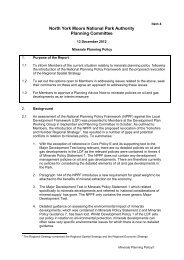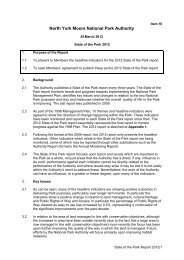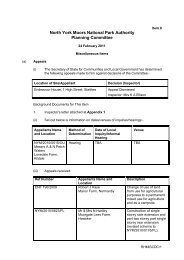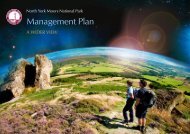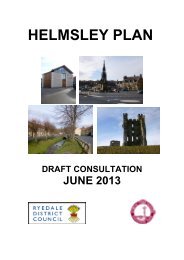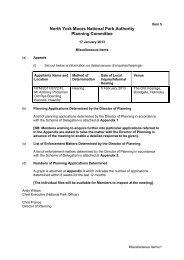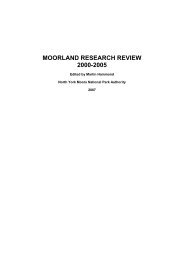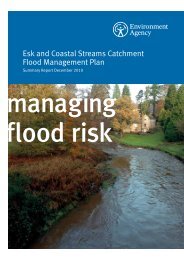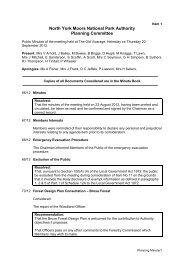Design Guide Part 3 - North York Moors National Park
Design Guide Part 3 - North York Moors National Park
Design Guide Part 3 - North York Moors National Park
- No tags were found...
You also want an ePaper? Increase the reach of your titles
YUMPU automatically turns print PDFs into web optimized ePapers that Google loves.
SECTION 3TREESSpecialist AdviceWhere trees are a significant factor on a development site, seeking advice from anarboriculturist at the outset could avoid later delays because all of the informationneeded to determine an application will have been provided. Overall costs could bereduced and the applicant is more likely to achieve a satisfactory balance betweentrees and the development of the site.3.3Land SurveysIn most cases a land survey will need to be undertaken to show all relevant existingsite features. These might include the location of vegetation on the site and onadjacent land where it might influence the site or affect landscape character (includingtrees, shrub areas and hedges) as well as other features such as streams, buildingsand boundary features. Recording spot heights throughout the site is important toprovide the basis for avoiding changes to soil levels around retained trees.3.4Tree SurveysWhere trees are present on or adjacent to a site a tree survey should always beundertaken prior to finalising any specific design for the development or submittinga planning application. It is important that the tree survey is undertaken at theoutset (with the Land Survey) to ensure that trees are fully considered at the designstage and so that the Authority has all the information it needs to be able to registerthe application when it is submitted.The tree survey should normally be undertaken by an arboriculturist or a suitablyqualified person, although occasionally this may not be a requirement (for exampleon small scale applications where trees will not be a major factor affecting thedevelopment).If there is any uncertainty about whether a tree survey is needed, or aboutthe level of professional input required, the applicant should contact theAuthority for advice.Existing trees should be plotted on a plan and cross referenced to the schedule tothe survey. The schedule should include all trees or groups of trees on or near thesite which have a stem diameter of 75mm or greater when measured at 1.5 metresabove ground. The following would normally be recorded:• A reference number for each tree (to be recorded on the tree survey planand cross referred to the tree schedule).• The species type (common and scientific names).• The height of the tree in metres.• The stem diameter in millimetres measured 1.5 metres above ground level.• Crown spread in metres taken at the four cardinal points to derive anaccurate representation of the crown (recorded on the tree survey plan).• The height, in metres, of the crown clearance above adjacent ground.• The age class (young, middle-aged, mature, over-mature, veteran).• The physiological condition (e.g. good, fair, poor, dead).• The structural condition (e.g. collapsing, the presence of any decay andphysical defects).• Preliminary management recommendations, including further investigationof suspected defects that require more detailed assessment and potentialfor wildlife habitat.• An estimation of the remaining contribution in years.• A category grading – to be recorded on the plan and in the schedule(category grading is set out in Figure 8 overleaf).49




